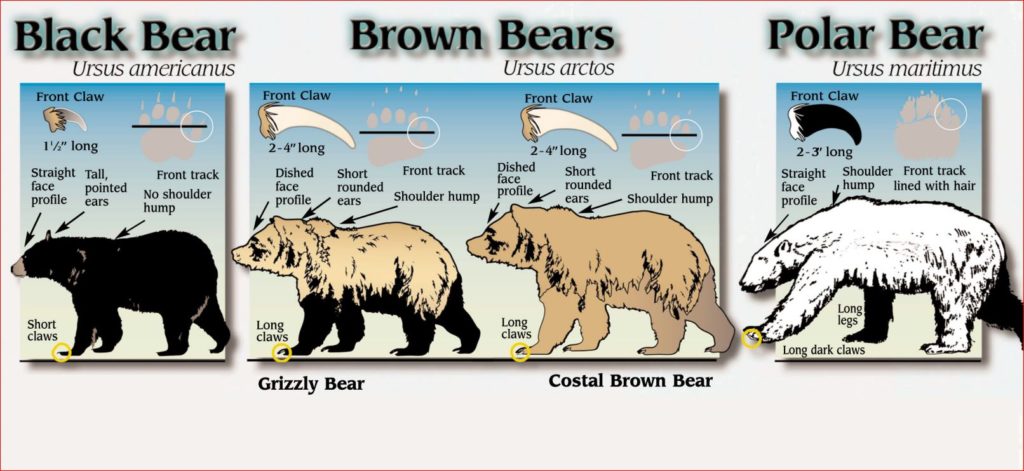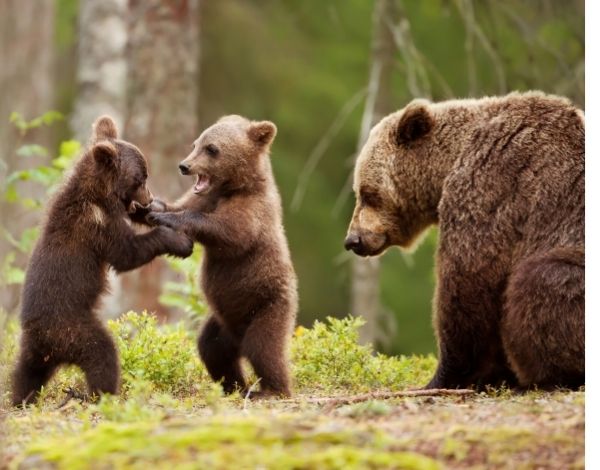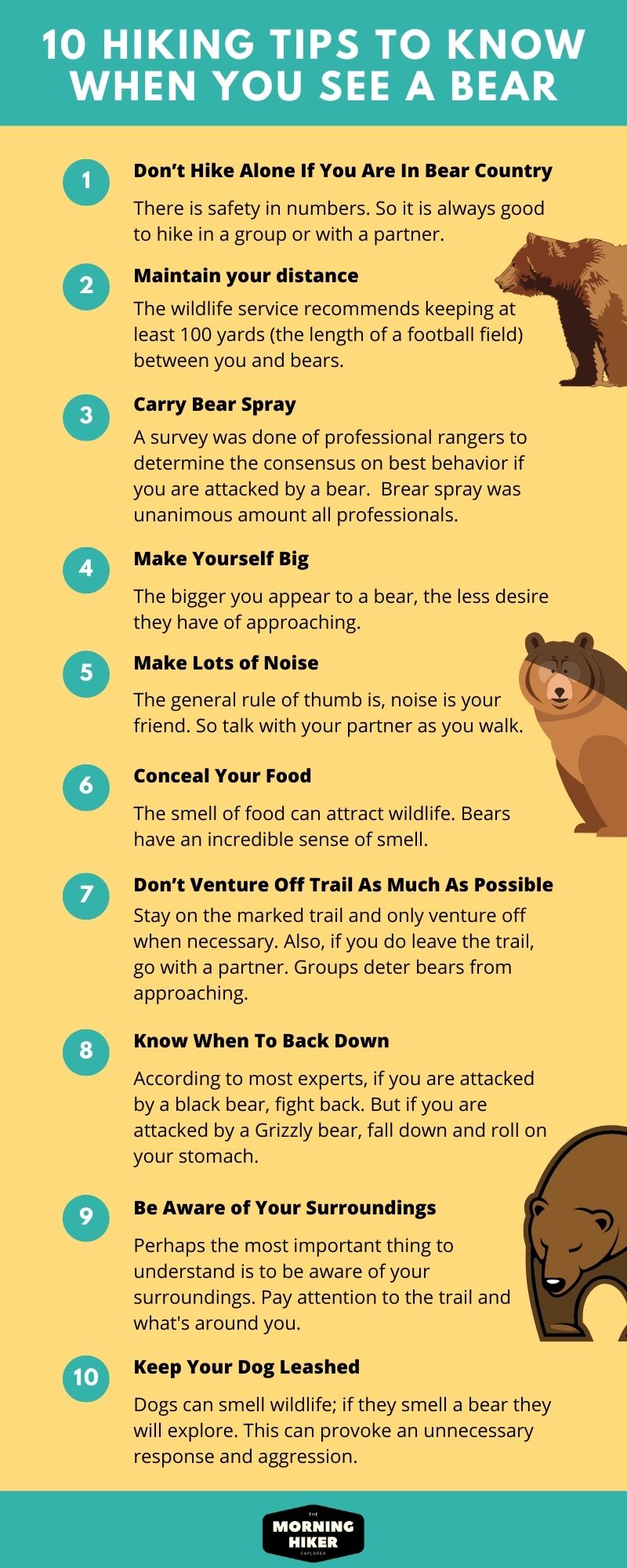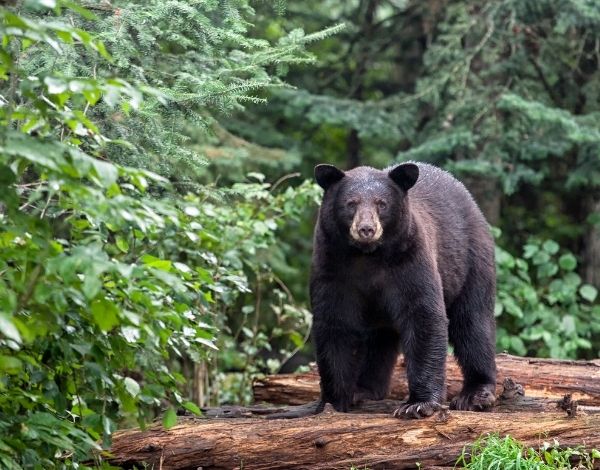Are you a hiker or backpacker? Maybe you’ve come across a bear in the wild. Do you know what to do when hiking where there are bears? If not, these tips will help you avoid dangerous situations and survive if you encounter one.
Did you know that bear attacks on humans are more common than you might expect? And, did you know that the majority of these attacks are deemed preventable? You don’t have to be Tim Tebow to be a good hiker.
This post contains some affiliate links to products that I use and love. If you click through and make a purchase, I’ll earn a commission, at no additional cost to you. Read my full disclosure here.
In This Article
Types of Bears You Might Encounter
In the northern hemisphere, there are seven major types of bear, and each type has its own unique characteristics. In this article, learn about these different bears and how to correctly identify them.
Bears are classified into three general categories: the brown bear, the polar bear and the black bear.
When you think of bears, you probably think of brown bears. But the most dangerous and widespread types of bears in North America are grizzlies and black bears. While brown bears can be found in all 50 states, they are the most common in Canada and Alaska.
Each region in the United States has specific types of bears that are indigenous to that region. There are many types of bears, but these are the most common.
For example, I grew up near Cheaha Mountain in Alabama. It is considered a branch of the Appalachia Mountains. On a few occasions, we would see Black Bears in the area.
When we lived in Colorado, Black Bears would often visit our area to rummage through trash cans. Deeper into the mountains of Colorado were Grizzly Bears (although rare to see).
The image below from BeBearAware.org shows the four types of bears in North America. The Polar Bear is mentioned but you will not encounter one in the United States.

Black Bear
Black Bears live in most of the States, as well as Canada and Mexico.
Brown Bear
Most of the US brown bears (generally referred to as Grizzly Bears), live in Alaska, Montana, Idaho, Wyoming and Washington. (Source)
Polar Bear
Polar Bears live in the Artic (Norther Canada). You will not find them in the United States.
Find Out More About Bears In Your Area
One of the best ways to determine the types of bear in your area is to research them.
You can find out more about bears in your area through the links provided below.
Learning about the habits and lives of these creatures will give you a good idea on what type of animal you’re dealing with. For example, the black bear is one of the common bear species, but they aren’t the only bear in the region. They are quite dominant in most areas.
The Brown bear is another one of the popular bear types found in North America. They have a very large population in the northeast and upper Midwest, but their range tends to expand a bit along the edges. These bears have adapted well to their cold environment and are usually seen in mountainous regions where they can spend the night.
As you can see, there are many different types of bears living in North America today. Each type of bear has its own characteristics and habits, as well as a variety of geographic locations. It is important to remember, however, that bears are considered to be endangered in many parts of their native habitats. If you plan to travel outside of grizzly country, it is important to be prepared for a dangerous encounter with one of these animals. Bears tend to have an instinct to protect their young, and if they are encountered, they can be extremely violent.
It is also important to understand that bears are part of the ecosystem that is found in many parts of the country. When visitors see a bear, it is generally a sign that there is a bear in the area and that there is a risk involved for people who are not familiar with the bear’s habits. Bears should be viewed as a part of the landscape and not as a threatening animal.
By knowing the different types of bears in the different regions of the country, it can help to ensure that any trips taken into wildlife-friendly territory are safe and enjoyable.
Find out more about bears in your area:
Map of Bear Population in the US
Black Bear Population by State
We also recommend talking to the Park Ranger in the area where you hike. They can inform you about recent bear sightings and provide information on places to avoid.
Understand Bear Behavior
The more you know about bear behavior, the better equipped you are to protect yourself and remain safe if you encounter one in the wild.

Giedrius Stakauskas
These tips from the National Forest Service will help protect yourself if you encounter a bear.
1) Bears Do Not Like Surprises
On of the most important things to remember when you encounter a bear is to remain calm. If you panick, chances are you will do something that makes the bear anxious. Because they are creatures of habit, any activity that surprises them can cause problems.
2) Bears Do Not Like To Feel Boxed In
Do your best to give bears plenty of room. Never make them feel crowded.
They become dangerous if they feel their ‘personal space’ is invaded. Therefore, give them plenty of space and try not to make quick moves. This startles them and can make them anxious.
The most important thing is the make sure they do not feel closed in. If you provide them a way to get out, they will more than likely take it.
The two main reasons they might become aggressive:
- They are protecting their cubs
- They are hungry and looking for food
3) Bears Love Food
They are always in search of the next meal. This is usually what attracts them to people – they smell food. The forest services recommend cooking away from your tent and never leave food for bears.
A few tips for storing food on a hiking/camping trip:
- Keep your camp clean
- Use storage containers to store food
- Hand your food out of reach of bears if possible
- Do not make it easy for bears to get food near you
Always be conscious of how you handle and contain your food sources.
4) Bears are Creatures of Habit
They like to travel the same trails, drink near the same streams, and live in the same area.
If you know bears are feeding near your hiking trail, it is best to avoid that trail unless you are experienced in dealing with wildlife.
5) Bears are Faster They Look
Do not run if you see a bear. They are much faster than you think. With speeds up to 35 MPH, they can out run most humans.
Because they do not like surprises, or sudden movements, it is best to stand still and follow the tips listed below.
10 Hiking Tips to Survive When You See a Bear
Learn how to become a safer hiker with these tips from experts. With a little preparation, you can avoid many of the common mistakes that other hikers make.

Here is a list of the 10 most common advice by professionals.
1) Don’t Hike Alone If You Are In Bear Country
I have taken short hikes by myself. But this is rare. And mostly in populated areas and trails. There is safety in numbers. So it is always good to hike in a group or with a partner.
2) Maintain your distance
The wildlife service recommends keeping at least 100 yards (the length of a football field) between you and bears.
Sometimes this is not possible when you walk up on a bear unexpectedly. But in most cases, keep your distance. And lots of it.
3) Carry Bear Spray
We always carry bear spray on long hikes. A study was done (sited below) of professional rangers to determine the consensus on best behavior if you are attacked by a bear. The recommendations varied significantly.
Some recommended fighting back. Others suggested falling down and rolling into a ball with your hands behind your neck. Two things they all (most) noted: climbing a tree is useless because black bears can climb, and using bear spray is one of the best defenses against a bear.
SABRE Frontiersman Bear Spray 7.9 oz (Holster Options & Multi-Pack Options) Maximum Strength & Larger Protective Barrier!
GREATEST PROTECTION AT A SAFE DISTANCE – 30 FEET: Traveling up to 10 feet (3 m) farther than other bear attack deterrents. The only bear spray with an in-house HPLC lab to guarantee maximum strength (50% stronger than Police Strength Pepper Spray) and eliminate the 30% fail rate experienced by other brands (U. of U.T.); MADE IN THE U.S.A.
4) Make Yourself Big
The bigger you appear to a bear, the less desire they have of approaching. To make yourself big, raise your arms and stretch your hands out wide. If you have a jacket on, spread it wide. This makes you appear bigger than you are.

Step by step:
- Raise your hands
- If you have trekking poles, raise them
- Make lots of noise
- Slowly back away
- Do NOT run
- Remain calm
- Do NOT lie down
5) Make Lots of Noise
People often wonder, ‘Do loud noises scare bears away?’ Generally, yes. But not always. It depends on what attracted them to come near.
For example, if you accidentally walked up on a bear and her cubs, loud noises can help deter an attack, but if she feels her cubs are threatened, noise is not enough.
The general rule of thumb is, noise is your friend. So talk with your partner as you walk.
Some people even wear a small bell that jingles while they walk, although this probably doesn’t make enough noise to deter a bear.
6) Conseal Your Food
The smell of food can attract wildlife. Bears have an incredible sense of smell.
If you are hiking overnight (or long day hike), make sure you put food in a ziplock bag. This will help keep the smell contained.
Also, make sure you do not leave garbage on hiking trails. This is sure to attract bears to the area and can present problems for hikers in the future. Leave no trace is the rule of the trail.
7) Don’t Venture Off Trail As Much As Possible
Avoid walking through brush areas. The last thing you want to do is surprise a bear.
Stay on the marked trail and only venture off when necessary. Also, if you do leave the trail, go with a partner. Groups deter bears from approaching.
8) Know When To Back Down
This is controversial, but Bringham Young University recommends standing your ground. Running signals submission on your part and could perpetrate an attack.
According to most experts, if you are attacked by a black bear, fight back. But if you are attacked by a Grizzly bear, fall down and roll on your stomach. I’ve heard it put like this:
If it’s brown, lie down. If it’s black, fight back!
Breeze Courier
In the video below, Matt Gutman talks with bear specialist Doug Seus about how to defend against a bear attack.
Note: For a detailed study on the different recommendations read this.
9) Be Aware of Your Surroundings
Perhaps the most important thing to understand is to be aware of your surroundings. Pay attention to the trail and what’s around you.
Also be aware of how you are presenting yourself. Perfume and cologne is not your friend on the trail. It only draws attention to a hungry predator.
Bears are more active in the early morning and late afternoon as they scoure for food. There are also certain of the year they are more active – Spring and Late Fall. During these times they can be in feeding frenzy. So be on guard.
10) Keep Your Dog Leashed
If you are hiking with a dog, always keep them on a leash.
Dogs can smell wildlife; if they smell a bear they will explore. This can provoke an unnecessary response and aggression. It can also cause a bear to follow your dog, leading them straight to you.
It’s best to keep your dog leashed. Their barking can be a deterrent to bears.
Final Thoughts on What To Do When Hiking Where Bears Are
Awareness of your surrounding and bear habits will help you enjoy your outdoor adventure.
Don’t be afraid, but do be aware. As we mentioned, bears are part of the wildlife ecosystem. If you respect them and their habitat it will be easier to protect yourself and have a more enjoyable experience.




We are participants in the Amazon Services LLC Associates Program, an affiliate advertising program designed to provide a means for sites to earn advertising fees by advertising and linking to Amazon.com